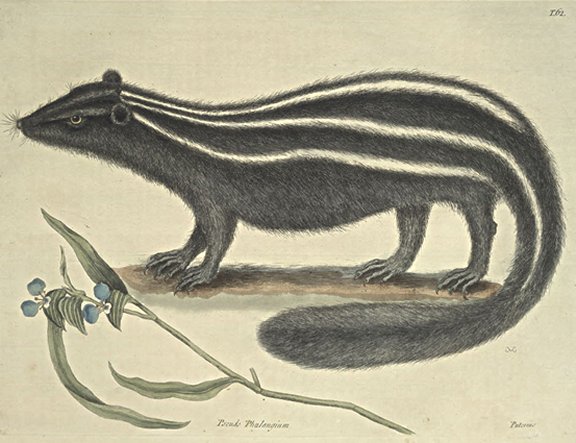Plate Number: II 62Putorius Americanus Striatus: The Pol-Cat This in Shape is not unlike our common Polcat, except that the Nose of this is somewhat longer: The Colour of all I have seen is black and white, tho' not always alike marked; this had a Lift of white, extending from the hind-part of the Head, along the Ridge of the Back, to the Rump, with four others, two an each Side, running parallel with it. When one of them is attacked by a Dog, to appear formidable, it so changes its usual Form, by bristling up its Hairs, and contracting its Length into a round Form, that it makes a very odd and terrible Appearance. This menacing, Behaviour, however insuffcient to deter its Enemy, is seconded by a Repulse far more prevailing, for from some secret Duct, it emits such fetid Effluviums, that the Atmosphere for a large Space round shall be so infected with them, that Men and other Animals are impatient till they are quit of it. This Stench is insupportable to some Dogs, and necessitates them to let their Game escape; others by thrusting their Noses into the Earth renew their Attacks till they have killed it, but rarely care to have more to do with such noisome Game, which for four or five Hours distracts them. The Indians notwithstanding esteem their Flesh a Dainty, of which I have eat, and found it well tasted. I have known them brought up young, made Domestick, and prove tame and very active, without exercising that Faculty, which Fear and Self-Preservation perhaps only prompts them to. They hide themselves in hollow Trees and Rocks, and are found in most of the Northern Continent of America. Their Food is Insects and wild Fruit. Pseudo-Phalangium ramosumThis Plant trails on the Ground. The Top of each Stalk terminates in a single hollow Leaf, which clasps almost close, and from its Footstalk arises short round Pedicles, supporting the Flowers, which consist of two blue Petals, standing erect on one Side, and one very small white Petal lying flat facing them, enclosed by a Calyx of three leaves; they contain several yellow, Stamina, and are succeeded by a Seed Vessel, containing three Seeds. |